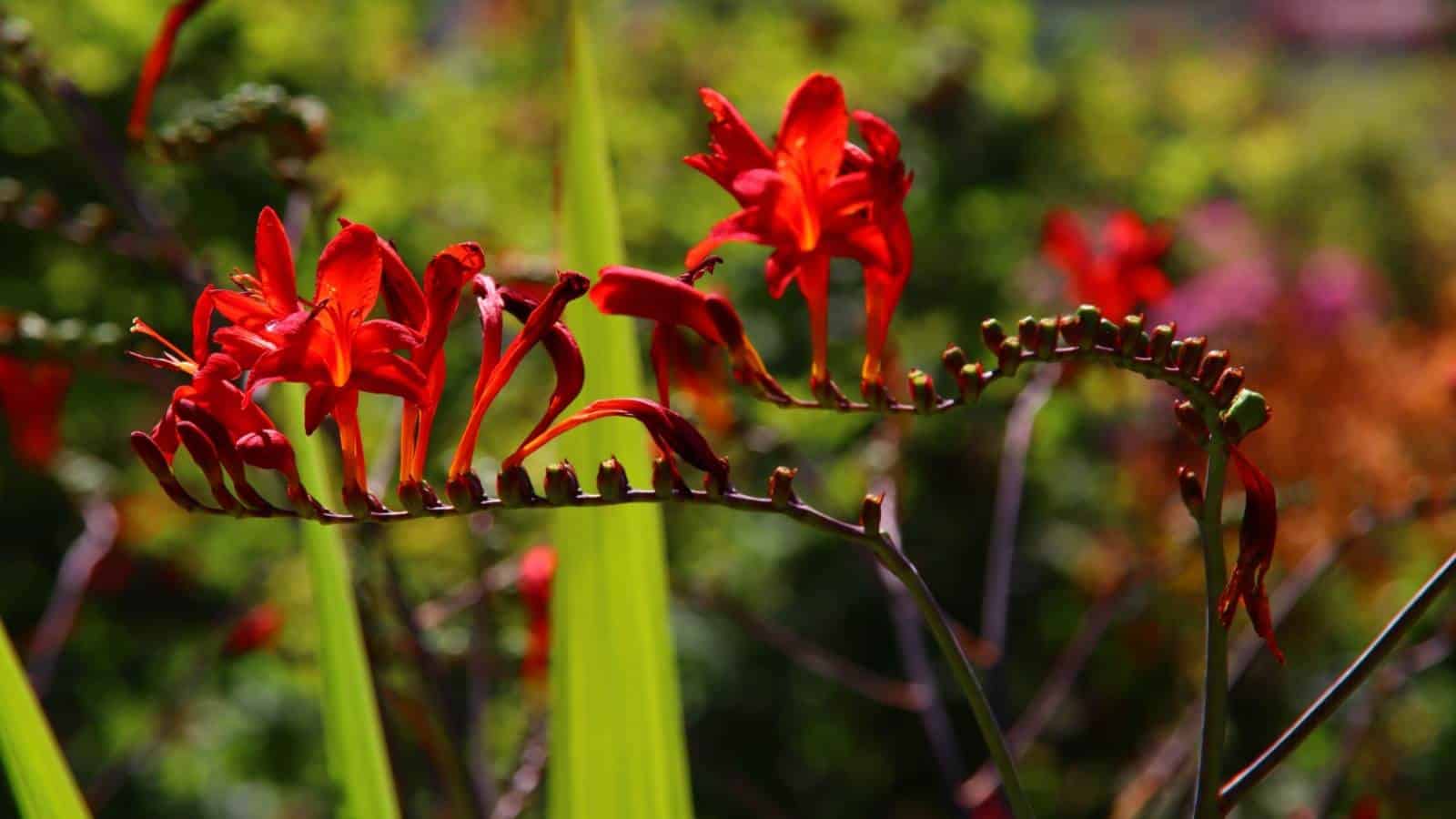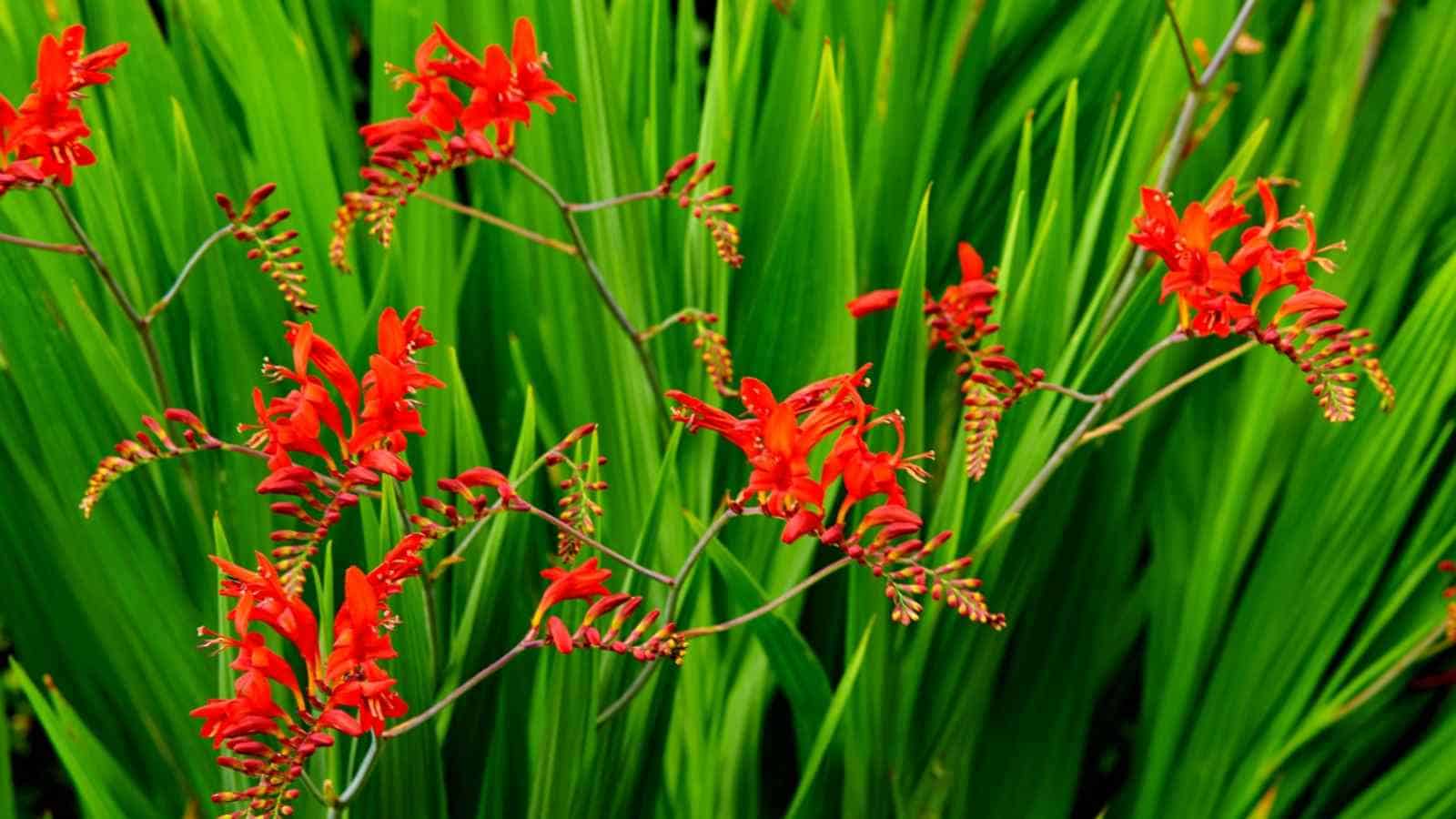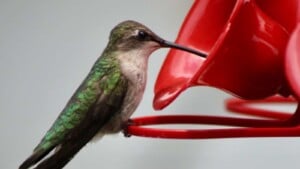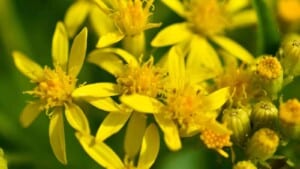Crocosmia is known for its gorgeous, brightly colored flowers that bloom in mid-summer.
Apart from being one of my favorite flowers, these summer-blooming bulbs typically come in shades of red, orange, and yellow, and attract hummingbirds and add color to gardens.
This excellent-cut flower is native to Eastern Africa but has become popular in gardens worldwide.
I’ve spent plenty of time learning how to grow Crocosmia and want to share my knowledge with you.
Whether you are planting Crocosmia for the first time or looking to improve your garden, my tips will cover everything you need to know about sowing and caring for this beautiful flower.
The Crocosmia Unveiled
- Scientific Name: Crocosmia aurea
- Other Common Names: Coppertips, Falling Stars, Montbretia, Valentine Flower
- Hardiness Zones: Zones 6-9 (USDA)
- Mature Crocosmia Height: 2-4 ft. tall, 1-2 ft. wide

Crocosmia is typically found in regions with full sun and well-drained soil.
Since it’s originally native to Eastern Africa, this summer-blooming plant thrives in environments with warm growing seasons. However, I’ve found it can also be winter-hardy in colder climates.
The plant’s shape features arching stems and sword-shaped leaves, contributing to its graceful appearance. Its tubular flowers form clusters, creating striking displays during late summer and early fall.
These characteristics are why I think Crocosmia makes for an attractive addition to garden beds and excellent cut flowers for arrangements.
Taking care of Crocosmia involves ensuring it has the right soil conditions and sufficient sunlight. Plant the corms in well-drained soil during spring and place them in a spot that receives full sun.
During the growing season, regular watering and occasional fertilizing will encourage more flowers and vibrant blooms.
I’ve found that most crocosmias are winter-hardy in the right hardiness zones. However, if you live in a colder area, I recommend mulching the ground year-round to protect the corms from severe frost.
Crocosmia Toxicity for Pets
Crocosmia plants are generally considered non-toxic to pets. This means there’s no need to worry if your dog or cat ingests parts of the plant since it’s unlikely to cause serious harm.
However, I recommend monitoring pets around your garden plants to prevent potential issues.
Cover your crocosmia corms properly and ensure your flower bulbs are correctly planted to reduce the risk of pets digging them up.
Does Crocosmia Multiply on Its Own?

Yes! I’ve found that Crocosmia corms multiply quickly, forming new corms that grow on top of each other in a conjoined string.
This may lead to overcrowding, especially as the new growth begins to bloom.
You can share some plants with friends to help manage flower production during bloom time.
NOTE: Crocosmia plants are slightly invasive, so you might end up with more than you initially wanted, especially if the corms are often pulled apart.
Popular Crocosmia Cultivars
I’ve cultivated various Crocosmia cultivars, each with unique characteristics and vibrant blooms. These cultivars are known for their brightly colored flowers and ability to thrive in various garden settings.
- Crocosmia ‘Lucifer’: One of the best Crocosmia varieties, Crocosmia Lucifer has fiery red flowers and arching stems. It is also cold-hardy compared to the other cultivars, and attracts plenty of hummingbirds.

- Crocosmia’ Emily McKenzie’: This variation is prized for its large, orange blooms with mahogany centers. The bloom time of this variety is around late summer.

- George Davidson: This cultivar offers bright yellow flowers that stand out in any garden.

- Fire King: This variation produces rich, orange-red blooms that are perfect for adding a splash of color to garden beds.

- Crocosmia’ Walbreyes’: This variety of Falling Stars is known as the ‘Star of the East’ for its large, star-shaped orange flowers.

- Crocosmia’ Prince of Orange’: This variation blooms into stunning, deep orange flowers that will be a focal point in any garden.

Ideal Growing Conditions for Crocosmia
In my experience, Crocosmia thrives in specific growing conditions. First, choose a location with full sun to partial shade to let the crocosmia bloom. Next, time your planting properly.
Crocosmia bulbs are best planted outdoors in the springtime. They don’t grow well in cold soil and may not sprout until the ground is warm enough.
The soil should be well-drained yet moist and enriched with organic material such as humus-rich compost or peat moss. This will support the plant’s vigorous growth and prolific flower clusters during the late summer.
When the leaves die during late fall, you can cut them back by 1-2 inches above ground level and leave the foliage for next year’s growth.
Sunlight and Shade Tolerance
Crocosmia can grow in partial shade. However, to ensure you grow even more flowers, I recommend exposing your plants to full sun. This will encourage vibrant blooms and healthy foliage.
Crocosmia grows best in areas that receive at least 6-8 hours of direct sunlight daily. It is also good for the plant to experience afternoon shade when planted in hot climates.
If your Crocosmia isn’t growing as expected, move it to a more suitable location to restore vigor.

Ideal Humidity Levels
I’ve learned Crocosmias grow best in drier climates with mild temperatures.
For areas that experience frequent frost and low temperatures, plant crocosmia in containers and move them inside for the fall and winter. This will help protect the plants from harsh conditions like cold winters and light frost.
Crocosmias also tolerate heat and humid climates but ensure the soil never completely dries out. In these areas, planting in spots with afternoon shade can help protect the flowers.
Keeping the soil moist and using organic mulch will help maintain the necessary humidity levels for growing Crocosmia.
Soils and Fertilization Schedule
Falling stars grow best in moist, humus-rich, well-drained soil. Avoid planting in heavy clays or soggy areas. Well-draining soil is vital to growing Crocosmia.
When planting Crocosmia, plant the bulbs about 3 to 4 inches deep and space them 6 to 8 inches apart. This ensures that the bulbs are well-covered and protected from light frost.
This will stabilize their growth, ensuring they produce healthy foliage and enough flowers during the growing season.
Fortunately, after you plant Crocosmia, they won’t need much care. Adding fertilizer can encourage foliage overgrowth, but this will replace flower blooms once growth starts, which isn’t ideal.

TIP: You can fix heavy clay soils with organic material, such as sand and peat moss, to create loose and aerated soil. Crocosmia also grows well in containers if they contain the needed nutrients.
When to Water Them
In my experience, Crocosmia doesn’t need constant watering. You can water your plants once a week so the topsoil is consistently moist.
Don’t water-log the plant, as this can cause root rot.
Water them as needed during bloom time to keep the soil evenly moist, giving your plants about an inch of water weekly. The right conditions will help you get the best crocosmia growth.
Keeping Your Crocosmia Safe During Winter
Crocosmias are winter hardy in zones 6-9. The bright red Lucifer cultivar will survive winters in zones 4 and 5.
If you’re concerned about hardiness, I advise treating crocosmias similarly to gladiolus. Dig the bulbs up after the first light frost and store them indoors in winter.
In colder areas, save the corms for next spring by digging them up. Remove any surplus soil, allow the corms to dry, then store them in trays in a cool place between 35°F and 45°F.
This ensures that your Crocosmia will be ready for planting and new growth when spring arrives.
Crocosmia Issues to Watch Out For
After planting your crocosmia bulbs, you might experience some problems that may affect their overall health and bloom quality.
I want to emphasize the importance of monitoring for potential issues and addressing them promptly.
By staying vigilant, you can ensure that your crocosmia plants, including varieties like crocosmia lucifer, will thrive throughout the growing season.
Pests

One of my favorite things about crocosmias is their resistance to rabbits and most pests. However, they’re particularly susceptible to spider mites.
Avoid an infestation by hosing the leaves down with a strong spray of water once or twice a week. This will dislodge any mites and create a sterile environment.
Soil that hasn’t drained properly can also increase the risk of spider mite infestations. However, neem oil can treat this problem.
Plant Diseases
Crocosmia can develop bacterial diseases in wet, poorly drained soil, which will spread quickly in warm, humid weather.
Symptoms include stunted growth and yellowing leaves. In some cases, plants may fail to emerge in spring.
To remedy this issue, plant crocosmia in well-draining soil and ensure the plants are properly spaced to promote air circulation around the foliage.
Other Guides from Planet Natural:
How to Plant, Grow and Care for Dianthus Flowers – Full Guide
How to Plant, Grow and Care for Lobelia Cardinalis – Full Guide











